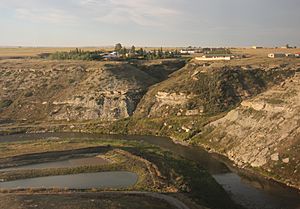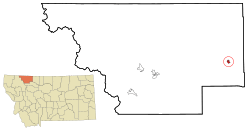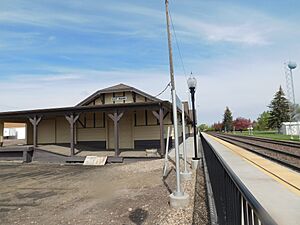Cut Bank, Montana facts for kids
Quick facts for kids
Cut Bank
|
|
|---|---|

Housing along Cut Bank Creek
|
|

Location of Cut Bank, Montana
|
|
| Country | United States |
| State | Montana |
| County | Glacier |
| Area | |
| • Total | 1.16 sq mi (3.01 km2) |
| • Land | 1.16 sq mi (3.00 km2) |
| • Water | 0.00 sq mi (0.01 km2) |
| Elevation | 3,773 ft (1,150 m) |
| Population
(2020)
|
|
| • Total | 3,056 |
| • Density | 2,641.31/sq mi (1,020.07/km2) |
| Time zone | UTC−7 (Mountain (MST)) |
| • Summer (DST) | UTC−6 (MDT) |
| ZIP code |
59427
|
| Area code(s) | 406 |
| FIPS code | 30-18775 |
| GNIS feature ID | 2410281 |
Cut Bank is a city in Montana, United States. It is the main town, or county seat, of Glacier County. The city gets its name from a deep gorge along Cut Bank Creek. In 2020, about 3,056 people lived there. The town started in 1891 when the Great Northern Railway arrived.
Contents
Exploring Cut Bank's Location
Cut Bank is in the eastern part of Glacier County. The Blackfeet Indian Reservation is located just west of the city. It sits on the western side of Cut Bank Creek.
The city is about 30 miles (48 km) south of the Canada–United States border. The "cut bank" that gives the city its name is a deep canyon. It's a beautiful natural feature. A scenic railway bridge crosses high above this canyon, not far from the town.
Weather in Cut Bank
Cut Bank has a semi-arid climate. This means it gets long, cold, and dry winters. Summers are short, warm, and a bit wetter.
In winter, very cold air from the Arctic often moves south. This makes Cut Bank one of the coldest places in the lower 48 states. This is because of its high elevation and location. Sometimes, warm Chinook winds blow in from the Rocky Mountains. These winds can quickly make the temperature much warmer.
| Climate data for Cut Bank, Montana (Cut Bank Municipal Airport), 1991–2020 normals, extremes 1903–present | |||||||||||||
|---|---|---|---|---|---|---|---|---|---|---|---|---|---|
| Month | Jan | Feb | Mar | Apr | May | Jun | Jul | Aug | Sep | Oct | Nov | Dec | Year |
| Record high °F (°C) | 67 (19) |
71 (22) |
77 (25) |
87 (31) |
91 (33) |
101 (38) |
106 (41) |
107 (42) |
97 (36) |
88 (31) |
79 (26) |
67 (19) |
107 (42) |
| Mean maximum °F (°C) | 54.8 (12.7) |
54.7 (12.6) |
62.5 (16.9) |
72.1 (22.3) |
80.4 (26.9) |
85.5 (29.7) |
93.1 (33.9) |
93.3 (34.1) |
88.0 (31.1) |
76.2 (24.6) |
61.9 (16.6) |
53.7 (12.1) |
95.3 (35.2) |
| Mean daily maximum °F (°C) | 32.3 (0.2) |
34.2 (1.2) |
42.6 (5.9) |
52.3 (11.3) |
62.3 (16.8) |
70.4 (21.3) |
80.2 (26.8) |
79.7 (26.5) |
68.7 (20.4) |
54.4 (12.4) |
41.0 (5.0) |
32.9 (0.5) |
54.2 (12.3) |
| Daily mean °F (°C) | 21.8 (−5.7) |
23.1 (−4.9) |
31.1 (−0.5) |
40.2 (4.6) |
49.6 (9.8) |
57.6 (14.2) |
64.9 (18.3) |
63.9 (17.7) |
54.4 (12.4) |
42.0 (5.6) |
30.6 (−0.8) |
22.8 (−5.1) |
41.8 (5.4) |
| Mean daily minimum °F (°C) | 11.3 (−11.5) |
12.0 (−11.1) |
19.7 (−6.8) |
28.1 (−2.2) |
37.0 (2.8) |
44.7 (7.1) |
49.6 (9.8) |
48.0 (8.9) |
40.1 (4.5) |
29.7 (−1.3) |
20.2 (−6.6) |
12.6 (−10.8) |
29.4 (−1.4) |
| Mean minimum °F (°C) | −18.9 (−28.3) |
−14.0 (−25.6) |
−5.6 (−20.9) |
11.6 (−11.3) |
23.4 (−4.8) |
34.8 (1.6) |
39.5 (4.2) |
37.2 (2.9) |
25.7 (−3.5) |
9.1 (−12.7) |
−6.8 (−21.6) |
−15.3 (−26.3) |
−28.8 (−33.8) |
| Record low °F (°C) | −46 (−43) |
−47 (−44) |
−34 (−37) |
−25 (−32) |
9 (−13) |
21 (−6) |
32 (0) |
25 (−4) |
−4 (−20) |
−14 (−26) |
−33 (−36) |
−46 (−43) |
−47 (−44) |
| Average precipitation inches (mm) | 0.22 (5.6) |
0.23 (5.8) |
0.36 (9.1) |
0.95 (24) |
1.65 (42) |
2.73 (69) |
1.29 (33) |
0.96 (24) |
1.08 (27) |
0.57 (14) |
0.42 (11) |
0.31 (7.9) |
10.77 (274) |
| Average snowfall inches (cm) | 4.0 (10) |
4.1 (10) |
6.8 (17) |
3.9 (9.9) |
1.2 (3.0) |
0.0 (0.0) |
0.0 (0.0) |
0.0 (0.0) |
0.4 (1.0) |
3.0 (7.6) |
5.6 (14) |
4.4 (11) |
33.4 (83.5) |
| Average precipitation days (≥ 0.01 in) | 4.2 | 4.2 | 5.9 | 7.9 | 9.8 | 11.3 | 6.7 | 6.1 | 6.5 | 5.1 | 4.8 | 4.2 | 76.7 |
| Average snowy days (≥ 0.1 in) | 4.9 | 4.8 | 7.0 | 3.2 | 0.9 | 0.0 | 0.0 | 0.0 | 0.5 | 2.5 | 4.5 | 5.2 | 33.5 |
| Source: NOAA (snow, snow days 1981–2010) | |||||||||||||
People of Cut Bank
| Historical population | |||
|---|---|---|---|
| Census | Pop. | %± | |
| 1900 | 43 | — | |
| 1910 | 500 | 1,062.8% | |
| 1920 | 1,181 | 136.2% | |
| 1930 | 845 | −28.5% | |
| 1940 | 2,509 | 196.9% | |
| 1950 | 3,721 | 48.3% | |
| 1960 | 4,539 | 22.0% | |
| 1970 | 4,004 | −11.8% | |
| 1980 | 3,688 | −7.9% | |
| 1990 | 3,329 | −9.7% | |
| 2000 | 3,105 | −6.7% | |
| 2010 | 2,869 | −7.6% | |
| 2020 | 3,056 | 6.5% | |
| source: U.S. Decennial Census |
|||
In 2010, there were 2,869 people living in Cut Bank. There were 1,249 households. About 739 families made their homes there.
Most people in the city were White (74.7%). A good number were Native American (19.0%). People from two or more races made up 5.2% of the population.
The average age of people in Cut Bank was 41.2 years old. About 24.4% of residents were under 18. About 16.8% were 65 years or older.
Learning in Cut Bank
Cut Bank has its own public school system. It includes both elementary and high schools. Students from kindergarten through 12th grade attend these schools. The sports teams at Cut Bank High School are called the Wolves.
The city also has a public library. It is known as the Glacier County Library.
News and Media
The local newspaper is called the Cut Bank Pioneer Press. It offers news in both print and online versions.
Getting Around Cut Bank
Cut Bank is a stop for Amtrak's Empire Builder train. This train travels long distances. It goes from Chicago to Seattle or Portland. One train goes east and one goes west each day.
The city's historic train station was recently repainted. It now looks like the old Great Northern depot. This was done with Amtrak and BNSF Railway.
Cut Bank also has an important railroad freight yard. It is run by the BNSF Railway.
The Cut Bank Municipal Airport is a public airport. It is located about 3 miles (5 km) southwest of the city.
U.S. Route 2 goes through Cut Bank. It is known as Main Street in the city. This road leads east to Interstate 15 at Shelby. It goes west to Browning.
Famous People from Cut Bank
- Gerard Jones - A writer known for comic books.
- Rosalie Mae Jones/Daystar - A choreographer and dancer. She started Daystar Contemporary Dance-Drama of Indian America.
- James C. Nelson - A justice on the Montana Supreme Court.
- Jordan Peccia - An Engineering professor at Yale University.
- Rob Quist - A musician.
- Glenn Roush - A state legislator in Montana.
- Hart Merriam Schultz - An American Indian artist.
- Gloria Jean Siebrecht - An amateur paleontologist.
- Alexis Wineman - Crowned Miss Montana in 2012.
- Danielle Wineman - Crowned Miss Montana in 2015.
See also
 In Spanish: Cut Bank (Montana) para niños
In Spanish: Cut Bank (Montana) para niños


